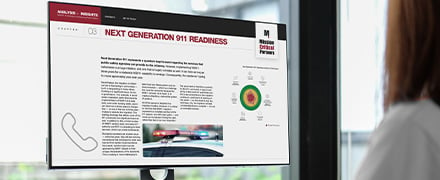CAD-to-CAD: Our Experts Weigh In
Posted on June 16, 2017 by Morgan Sava
Is your 9-1-1 agency considering a CAD-to-CAD capability to increase information sharing and data interoperability between jurisdictions?
We recently asked two MCP subject-matter experts to weigh in on the topic of CAD-to-CAD. Last month, we hosted a webinar to discuss the benefits and technical considerations of a CAD-to-CAD approach, as well as where to begin from a technical standpoint if they decide to implement this solution (Watch the webinar on-demand here.)
In this post, we’ll investigate the benefits as well as the varying models available in today’s market. Be on the lookout for a future discussion on CAD-to-CAD guiding principles and how an agency should begin their journey.
CAD-to-CAD Information-Sharing Benefits
Every public safety answering point (PSAP) director can cite at least one incident when an information-sharing model such as CAD-to-CAD would have positively impacted their emergency response time and produced significantly less stress. CAD-to-CAD setups produce major opportunities for information sharing and offer benefits such as:
- Significantly reduced response times
- Decreased or eliminated potential for communications errors
- Real-time information sharing
- Improved accuracy of transmitted information
- Increased situational awareness
- Direct access to CAD event data by more entities
- Enabling field units to be directly dispatched from their own dispatch center
One MCP client that leverages CAD-to-CAD technology has significantly reduced its time to dispatch by a consistent 90 seconds.
These solutions have proven effective in helping agencies increase their ability to understand when units are in the field, when they are available but in the station, and when they are out of service. Another advantage is that events can be created and critical information about an incident can be shared with every jurisdiction’s first responders responding to an emergency.
CAD-to-CAD enables call details to be updated in real time while incident information is passed to mobile response units that are linked to the CAD system as a scene unfolds. Information is typically more accurate because first responders have access to precise dispatch, response and on-scene times, as well as personal accountability reports (PAR) for future reporting needs.
Clearly, the benefits of CAD-to-CAD information sharing are enormous for first responders. But just as clearly, deploying this model is not an easy undertaking and requires a tremendous amount of technical expertise, planning and coordination.
Alternative Models of CAD-to-CAD Solutions
There are essentially two CAD-to-CAD information sharing models available: a one-to-one custom interface or a data exchange hub (DEH).
One-to-One Custom Interface
The first model, defined very simply, connects one CAD system with another CAD system to share data; the connection that enables the data transfer is made possible via a custom interface responsible for running queries between two jurisdictions.
In this model, CAD vendor A serving one jurisdiction develops an interface with CAD vendor B serving the other jurisdiction, and builds tables to assimilate data nomenclatures, fields and protocols, which enables data transfer. This model also can be used when two neighboring jurisdictions share a CAD vendor but have different version numbers, which causes data-integration issues.
Data Exchange Hub
In contrast, the DEH enables many CAD systems across several jurisdictions to interconnect. In this model, the DEH completes the data-translation tasks required and transmits the information to the appropriate PSAP. This is accomplished by a single third-party vendor that works with each of the CAD vendors involved from each jurisdiction or agency. This DEH vendor is accountable for all data exchanges and ensuring that properly formatted data is passed to the appropriate receiving CAD system at the neighboring agency.
In this model, jurisdictions typically pay a portion of development, implementation and maintenance costs to the DEH vendor. This model is appealing to larger regional groups and the major benefits again are decreased dispatch and response time.
Advantanges and Disadvantages
The custom-interface model traditionally is preferred by smaller CAD integration initiatives rather than larger, regional deployments. The costs to develop and maintain such interfaces are assumed by the respective jurisdictions that are interconnected via the interface. One major advantage of this setup is that third-party vendors are not needed to create the interface because the CAD vendors involved create the design. Interface maintenance usually is included as part of the upfront development costs because once the CAD vendor creates the interface, it owns it long-term. This model reduces an agency’s risk of failure because no stop is required as data travels to the neighboring PSAP’s CAD system. Of the two approaches, the custom-interface model provides a more-streamlined network connection.
One primary advantage of the DEH model is the ability to bring in a third-party to manage the impact of changes or upgrades to the individual CAD systems, taking the onus off individual jurisdictions to coordinate and facilitate those. It also offers a more-consistent pricing and cost-sharing model compared with seeking individual quotes for interface development for each desired interconnection. The DEH model is easier to sustain long-term—new jurisdictions can join the system easily at a lower cost point with less development required. Other public safety applications, such as records management systems (RMS) can be added downstream.
Conclusion
Regardless of the approach taken, a CAD-to-CAD capability will significantly reduce dispatch times, which in turn will get first responders to the scene of an emergency faster—which is a critical consideration when lives and property are in grave danger and every second counts.
If you're looking for support managing your CAD-to-CAD initiative, MCP's technology procurement and integration services can help operationalize your new technology faster and assure that it's performing optimally while delivering your agency maximum value.
Topics: Technology, Data Integration and Analytics







